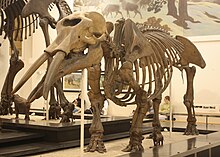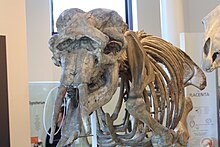| Gomphotherium Temporal range:
| |
|---|---|

| |
| Specimen of Gomphotherium productum at the American Museum of Natural History | |
|
Scientific classification
| |
| Domain: | Eukaryota |
| Kingdom: | Animalia |
| Phylum: | Chordata |
| Class: | Mammalia |
| Order: | Proboscidea |
| Family: | † Gomphotheriidae |
| Genus: | †
Gomphotherium Burmeister, 1837 |
| Type species | |
| Gomphotherium angustidens (Cuvier, 1817)
| |
| Species | |
|
See text | |
| Synonyms | |
Gomphotherium ( /ˌɡɒmfəˈθɪəriəm/; "nail beast" for its double set of straight tusks) is an extinct genus of gomphothere proboscidean from the Neogene of Eurasia, Africa and North America. [1] [2] The genus is probably paraphyletic. [3] [4]
Description

Most species of Gomphotherium were similar in size to the Asian elephant, with G. productum (known from a 35-year-old male) measuring 2.51 m (8 ft 3 in) tall and weighing 4.6 t (4.5 long tons; 5.1 short tons). The largest species G. steinheimense, known from a complete 37-year-old male found in Mühldorf, Germany, measured up to 3.17 m (10.4 ft) tall and weighed 6.7 t (6.6 long tons; 7.4 short tons). [5]
Gomphotherium, like most primitive elephantimorphs, had an elongated lower jaw which bore tusks. [6] Species of Gomphotherium are defined by their conservative molar morphology, which includes "trilophed intermediate molars, third molars with three to four loph(id)s, and pretrite half-loph(id)s typically with anterior and posterior accessory conules that form trefoil-patterned enamel loops with wear (simple molar crowns with no accessory conules on the posttrite side of the crown)". [7]
Ecology
Most species of Gomphotherium are inferred to have been browsers or mixed feeders, but specimens of G. steinheimense from China are suggested to have been grazers. [3]
Evolution

Gomphotherium likely originated in Africa during the late Oligocene-early Miocene. The oldest remains of Gomphotherium are known from Africa, dating to approximately 19.5 million years ago. [8] Gomphotherium migrated into Eurasia across the " Gomphotherium land bridge" approximately 19 million years ago. [9] Gomphotherium underwent rapid evolution after its arrival in Eurasia, reaching its peak diversity during the Early-Middle Miocene. [9] Gomphotherium has been posited to be paraphyletic and the ancestor of later gomphothere genera, including the "tetralophodont gomphotheres" such as Tetralophodon which are probably ancestral to stegodontids and elephantids. [3] Gomphotherium first arrived in North America during the mid-Miocene, approximately 16-15 million years ago, [10] and is suggested to be ancestral to later New World gomphothere genera, such as Cuvieronius, Stegomastodon and Rhynchotherium. [11] Asian populations of Gomphotherium are suggested to have been ancestral to Sinomastodon. [12] The last European species of Gomphotherium became extinct at the beginning of the Late Miocene, around the start of MN9, approximately 10 million years ago. [12] The last Gomphotherium species disappeared from North America at the beginning of the Pliocene, approximately 5 million years ago. [10]
Taxonomy
The following cladogram shows the placement of the genus Gomphotherium among other proboscideans, based on hyoid characteristics: [13]
| ||||||||||||||||||||||||||||||||||
Species
Over a dozen species of Gomphotherium are considered valid, with over 30 junior synonyms proposed for these taxa. [14]
- G. hannibali Welcomme, 1994 Europe, Early Miocene
- G. annectens (Matsumoto, 1925) Japan, Early Miocene
- G. cooperi (Osborn, 1932) Asia, Early Miocene
- G. sylvaticum Tassy, 1985 Europe, Early Miocene
- G. libycum (Fourtau, 1918) Egypt, Early Miocene
- G. inopinatum (Borissiak and Belyaeva, 1928) China, late Early Miocene-Early middle Miocene
- G. mongoliense ( Osborn, 1924) Mongolia, late Early Miocene-Early middle Miocene
- G. angustidens (Cuvier, 1817) (type) Europe, Middle Miocene
- G. subtapiroideum (Schlesinger, 1917) Europe, Early-Middle Miocene
- G. tassyi Wang, Li, Duangkrayom, Yang, He & Chen, 2017 China, Middle Miocene
- G. browni (Osborn, 1926) Pakistan, Middle Miocene
- G. steinheimense (Klahn, 1922) Europe, China, Middle-Late Miocene
- G. productum (Cope, 1874) North America, Middle Miocene-Early Pliocene
- G. pyrenaicum (Lartet, 1859) Europe, Middle Miocene [15]
Phylogeny after Wang et al., 2017 [14]
|
Outgroups "G. annectens group" "G. angustidens group" "Derived Gomphotherium" | ||||||||||||||||||||||||||||||||||||||||||||||||||||||||||||||||||||||||||||||||||||||||||||||||||||
-
Gomphotherium angustidens
-
Gomphotherium productum
-
G. angustidens by Charles R. Knight
-
G. angustidens skeleton
References
- ^ Wang, Wei; Liao, Wei; Li, Dawei; Tian, Feng (1 July 2014). "Early Pleistocene large-mammal fauna associated with Gigantopithecus at Mohui Cave, Bubing Basin, South China". Quaternary International. 354: 122–130. Bibcode: 2014QuInt.354..122W. doi: 10.1016/j.quaint.2014.06.036. ISSN 1040-6182.
- ^ Palmer, T. S.; Merriam, C. H. (1904). Index generum mammalium: a list of the genera and families of mammals. Government Printing Office, Washington.
- ^ a b c Wu, Yan; Deng, Tao; Hu, Yaowu; Ma, Jiao; Zhou, Xinying; Mao, Limi; Zhang, Hanwen; Ye, Jie; Wang, Shi-Qi (16 May 2018). "A grazing Gomphotherium in Middle Miocene Central Asia, 10 million years prior to the origin of the Elephantidae". Scientific Reports. 8 (1): 7640. Bibcode: 2018NatSR...8.7640W. doi: 10.1038/s41598-018-25909-4. ISSN 2045-2322. PMC 5956065. PMID 29769581.
- ^ Baleka, Sina; Varela, Luciano; Tambusso, P. Sebastián; Paijmans, Johanna L.A.; Mothé, Dimila; Stafford, Thomas W.; Fariña, Richard A.; Hofreiter, Michael (January 2022). "Revisiting proboscidean phylogeny and evolution through total evidence and palaeogenetic analyses including Notiomastodon ancient DNA". iScience. 25 (1): 103559. Bibcode: 2022iSci...25j3559B. doi: 10.1016/j.isci.2021.103559. PMC 8693454. PMID 34988402.
- ^ Larramendi, A. (2016). "Shoulder height, body mass and shape of proboscideans" (PDF). Acta Palaeontologica Polonica. 61. doi: 10.4202/app.00136.2014. S2CID 2092950.
- ^ Mothé, Dimila; Ferretti, Marco P.; Avilla, Leonardo S. (12 January 2016). Beatty, Brian Lee (ed.). "The Dance of Tusks: Rediscovery of Lower Incisors in the Pan-American Proboscidean Cuvieronius hyodon Revises Incisor Evolution in Elephantimorpha". PLOS ONE. 11 (1): e0147009. Bibcode: 2016PLoSO..1147009M. doi: 10.1371/journal.pone.0147009. ISSN 1932-6203. PMC 4710528. PMID 26756209.
- ^ Sanders, William J. (7 July 2023). Evolution and Fossil Record of African Proboscidea (1 ed.). Boca Raton: CRC Press. p. 94. doi: 10.1201/b20016. ISBN 978-1-315-11891-8.
- ^ Wang, Shi-Qi; Li, Yu; Duangkrayom, Jaroon; Yang, Xiang-Wen; He, Wen; Chen, Shan-Qin (4 May 2017). "A new species of Gomphotherium (Proboscidea, Mammalia) from China and the evolution of Gomphotherium in Eurasia". Journal of Vertebrate Paleontology. 37 (3): e1318284. Bibcode: 2017JVPal..37E8284W. doi: 10.1080/02724634.2017.1318284. ISSN 0272-4634. S2CID 90593535.
- ^ a b Li, Chunxiao; Wang, Shi-Qi; Yang, Qing (26 May 2022). "Discovery of a primitive Gomphotherium from the Early Miocene of northern China and its biochronology and palaeobiogeography significance". Historical Biology: 1–9. doi: 10.1080/08912963.2022.2077106. ISSN 0891-2963. S2CID 249145789.
- ^ a b MacFadden, Bruce J.; Morgan, Gary S.; Jones, Douglas S.; Rincon, Aldo F. (March 2015). "Gomphothere proboscidean ( Gomphotherium ) from the late Neogene of Panama". Journal of Paleontology. 89 (2): 360–365. Bibcode: 2015JPal...89..360M. doi: 10.1017/jpa.2014.31. ISSN 0022-3360. S2CID 52093950.
- ^ Spencer LG 2022. The last North American gomphotheres. N Mex Mus Nat Hist Sci. 88:45–58.
- ^ a b Wang, Shi-Qi; Ji, Xue-Ping; Jablonski, Nina G.; Su, Denise F.; Ge, Jun-Yi; Ding, Chang-Fen; Yu, Teng-Song; Li, Wen-Qi; Duangkrayom, Jaroon (June 2016). "The Oldest Cranium of Sinomastodon (Proboscidea, Gomphotheriidae), Discovered in the Uppermost Miocene of Southwestern China: Implications for the Origin and Migration of This Taxon". Journal of Mammalian Evolution. 23 (2): 155–173. doi: 10.1007/s10914-015-9311-z. ISSN 1064-7554. S2CID 254702519.
- ^ Shoshani, J.; Tassy, P. (2005). "Advances in proboscidean taxonomy & classification, anatomy & physiology, and ecology & behavior". Quaternary International. 126–128: 5–20. Bibcode: 2005QuInt.126....5S. doi: 10.1016/j.quaint.2004.04.011.
- ^ a b Wang, Shi-Qi; Li, Yu; Duangkrayom, Jaroon; Yang, Xiang-Wen; He, Wen; Chen, Shan-Qin (4 May 2017). "A new species of Gomphotherium (Proboscidea, Mammalia) from China and the evolution of Gomphotherium in Eurasia". Journal of Vertebrate Paleontology. 37 (3): e1318284. Bibcode: 2017JVPal..37E8284W. doi: 10.1080/02724634.2017.1318284. ISSN 0272-4634. S2CID 90593535.
- ^ Göhlich, Ursula B. (2010). "The Proboscidea (Mammalia) from the Miocene of Sandelzhausen (southern Germany)". Paläontologische Zeitschrift. 84 (1): 163–204. doi: 10.1007/s12542-010-0053-1.






